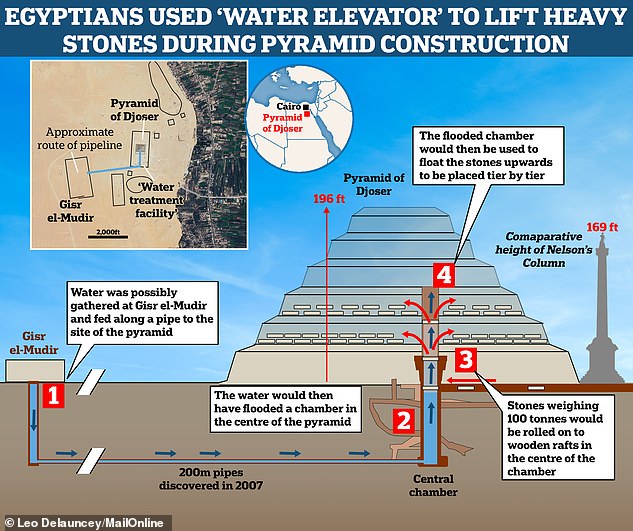It has long been a matter of debate: how exactly were the great pyramids of Egypt built by the civilized world’s first engineers?
A popular theory suggests that they used a system of ropes and sleds to transport stones to the top as the pyramid was built from scratch, layer by layer.
But a new study suggests that Egypt’s oldest pyramid, the Pyramid of Djoser, was built 4,700 years ago using an even more ingenious “hydraulic lift.”
“The ancient Egyptians are famous for their pioneering and mastery of hydraulics through canals for irrigation purposes and barges to transport huge stones,” the team explained.
‘This work opens a new line of research: the use of hydraulic power to erect the enormous structures built by the pharaohs.’
A new study suggests that Egypt’s oldest pyramid, the Pyramid of Zoser, was built using an ingenious “hydraulic elevator.” A huge jet of water shot through the center of the pyramid “like a volcano” and pushed the stones to the top, researchers believe.

The Step Pyramid of Djoser is 200 feet tall (60 m) and is believed to be the first pyramid in Egypt.
The new theory is presented in a new study led by Xavier Landreau, president of Paleotechnic, an archaeological research institute in Paris, France.
The researchers studied historical records and satellite photographs of the area to interpret the features that support their argument.
“We identified that the internal architecture of the step pyramid is consistent with a hydraulic lifting mechanism never before reported,” say Landreau and colleagues.
‘The ancient architects probably raised the stones in the centre of the pyramid in the manner of a volcano, using water without sediment.’

While the axis at the centre of the pyramid (pictured) was already known, researchers now present a new theory about its purpose.

The Pyramid of Zoser, the oldest in the world, was built south of modern Cairo, 4,500 years ago, just east of the Nile, the longest river in the world.
Djoser’s pyramid, about 200 feet tall, is a “step pyramid,” meaning its sides are a series of flat platforms or steps, unlike the comparatively level sides of the famous pyramid at Giza.
Although Giza is the largest pyramid in Egypt, Djoser’s is the oldest, having been built sometime between 2667 and 2648 BC.
The impressive structure was built entirely of stone by the ancient Egyptian architect Imhotep in the vast necropolis of Saqqara, south of Cairo.
It is believed to be the final resting place of King Djoser, ancient Egyptian pharaoh and founder of the Old Kingdom.
Although the existence of a huge pit in the centre of the pyramid was already known, researchers now present a new theory about its purpose.
First, they point to Gisr el-Mudir, an ancient stone structure less than a mile west of Djoser’s pyramid.

Gisr el-Mudir is one of the oldest known stone structures in Egypt, just a few hundred meters west of the Pyramid of Djoser. The function of this space has long been unclear. Pictured: Egyptian archaeologists at Gisr el-Mudir in January 2023

The Pyramid of Zoser is believed to be the final resting place of King Zoser (pictured), an ancient Egyptian pharaoh and founder of the Old Kingdom.
The function of Gisr el-Mudir has never been certain, but researchers say it may have acted as a dam, collecting rainwater and directing it toward the pyramid through a system of pipes.
Once the groundwater reached the center of the pyramid, it flowed upward through the central well like magma in a volcano.
This powerful jet of water would have pushed up a floating elevator – a level platform probably made of wood – that could transport up to 100 tons of stone at a time thanks to the force of the water.
According to experts, the water jet could be controlled to empty the pit, leaving it ready to be reused for another load of stone.
Potentially, water could be blocked at the base of the pyramid’s shaft as a sort of plug before being released when the next load was placed.

The Pyramid of Zoser reopened to visitors in 2020 after 14 years of restoration. Pictured in the background during a press event in January 2023

View of pharaonic inscriptions in a tomb dating back to the Old Kingdom, at the site of the Step Pyramid of Zoser in Saqqara, on January 26, 2023
Although this newly postulated system sounds especially complex for 4,700 years ago, the pyramids themselves are evidence that the ancient Egyptians were perhaps more skilled engineers than we give them credit for.
Gisr el-Mudir was previously thought to be a livestock enclosure, a ceremonial place for worshipping the gods, or even an unfinished pyramid.
But the theory that it was a dam provides a compelling link to the central shaft of the Pyramid of Djoser, which reopened to visitors in 2020 after 14 years of restoration.
It is unclear whether other famous Egyptian pyramids might have used this construction technique; MailOnline has contacted experts for more information.
The new study describing the theory has been published In the diary Plus one.


